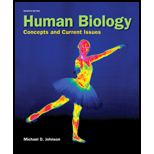
HUMAN BIOLOGY:CONC.+CURRENT..(LOOSE)
7th Edition
ISBN: 9780321862525
Author: Johnson
Publisher: PEARSON
expand_more
expand_more
format_list_bulleted
Concept explainers
Textbook Question
Chapter 4, Problem 6CR
Define interstitial fluid.
Expert Solution & Answer
Want to see the full answer?
Check out a sample textbook solution
Students have asked these similar questions
Which evidence-based stress management techniques are most effective in reducing chronic stress and supporting college students’ academic success?
students in a science class investiged the conditions under which corn seeds would germinate most successfully. BAsed on the results which of these factors appears most important for successful corn seed germination.
I want to write the given physician orders in the kardex form
Chapter 4 Solutions
HUMAN BIOLOGY:CONC.+CURRENT..(LOOSE)
Ch. 4 - Health clinics sometimes cite retrospective...Ch. 4 - How important to you is FDA approval and/or...Ch. 4 - Describe some advantages and disadvantages of...Ch. 4 - Name the four main types of tissues in the human...Ch. 4 - Prob. 3CRCh. 4 - Prob. 4CRCh. 4 - List the 11 organ systems of the body and give at...Ch. 4 -
6. Define interstitial fluid.
Ch. 4 - Name the two cavities of the anterior body cavity...Ch. 4 - Prob. 8CR
Ch. 4 - Discuss the purpose of homeostasis in the body.Ch. 4 - Prob. 10CRCh. 4 -
1. Collagen and elastin fibers are typically...Ch. 4 -
2. Cells in cardiac muscle are able to contract...Ch. 4 - Which of the following membranes is not composed...Ch. 4 -
4. Exocrine and endocrine glands are types...Ch. 4 - Prob. 5TYCh. 4 - What property do all muscle tissues have in...Ch. 4 -
7. Injury to bone heals more quickly than injury...Ch. 4 - Which of the following tissues may be found in the...Ch. 4 - Which of the following is responsible for skin...Ch. 4 - Prob. 10TYCh. 4 - Prob. 11TYCh. 4 - Prob. 12TYCh. 4 - A substantial amount of nonliving extracellular...Ch. 4 - Prob. 14TYCh. 4 - Reducing food intake may lead to weight loss by...Ch. 4 -
1. Your roommate says that the concept of...Ch. 4 - What do you think would be some of the problems...Ch. 4 - Sherlock Holmes, the greatest fictional detective...Ch. 4 -
4. Dieting is difficult. People who do manage to...Ch. 4 - Fibrous connective tissue consists of ground...Ch. 4 -
6. By definition, an organ is a structure...
Knowledge Booster
Learn more about
Need a deep-dive on the concept behind this application? Look no further. Learn more about this topic, biology and related others by exploring similar questions and additional content below.Similar questions
- Amino Acid Coclow TABle 3' Gly Phe Leu (G) (F) (L) 3- Val (V) Arg (R) Ser (S) Ala (A) Lys (K) CAG G Glu Asp (E) (D) Ser (S) CCCAGUCAGUCAGUCAG 0204 C U A G C Asn (N) G 4 A AGU C GU (5) AC C UGA A G5 C CUGACUGACUGACUGAC Thr (T) Met (M) lle £€ (1) U 4 G Tyr Σε (Y) U Cys (C) C A G Trp (W) 3' U C A Leu בוט His Pro (P) ££ (H) Gin (Q) Arg 흐름 (R) (L) Start Stop 8. Transcription and Translation Practice: (Video 10-1 and 10-2) A. Below is the sense strand of a DNA gene. Using the sense strand, create the antisense DNA strand and label the 5' and 3' ends. B. Use the antisense strand that you create in part A as a template to create the mRNA transcript of the gene and label the 5' and 3' ends. C. Translate the mRNA you produced in part B into the polypeptide sequence making sure to follow all the rules of translation. 5'-AGCATGACTAATAGTTGTTGAGCTGTC-3' (sense strand) 4arrow_forwardWhat is the structure and function of Eukaryotic cells, including their organelles? How are Eukaryotic cells different than Prokaryotic cells, in terms of evolution which form of the cell might have came first? How do Eukaryotic cells become malignant (cancerous)?arrow_forwardWhat are the roles of DNA and proteins inside of the cell? What are the building blocks or molecular components of the DNA and proteins? How are proteins produced within the cell? What connection is there between DNA, proteins, and the cell cycle? What is the relationship between DNA, proteins, and Cancer?arrow_forward
- please fill in the empty sports, thank you!arrow_forwardIn one paragraph show how atoms and they're structure are related to the structure of dna and proteins. Talk about what atoms are. what they're made of, why chemical bonding is important to DNA?arrow_forwardWhat are the structure and properties of atoms and chemical bonds (especially how they relate to DNA and proteins).arrow_forward
- The Sentinel Cell: Nature’s Answer to Cancer?arrow_forwardMolecular Biology Question You are working to characterize a novel protein in mice. Analysis shows that high levels of the primary transcript that codes for this protein are found in tissue from the brain, muscle, liver, and pancreas. However, an antibody that recognizes the C-terminal portion of the protein indicates that the protein is present in brain, muscle, and liver, but not in the pancreas. What is the most likely explanation for this result?arrow_forwardMolecular Biology Explain/discuss how “slow stop” and “quick/fast stop” mutants wereused to identify different protein involved in DNA replication in E. coli.arrow_forward
arrow_back_ios
SEE MORE QUESTIONS
arrow_forward_ios
Recommended textbooks for you
 Principles Of Radiographic Imaging: An Art And A ...Health & NutritionISBN:9781337711067Author:Richard R. Carlton, Arlene M. Adler, Vesna BalacPublisher:Cengage Learning
Principles Of Radiographic Imaging: An Art And A ...Health & NutritionISBN:9781337711067Author:Richard R. Carlton, Arlene M. Adler, Vesna BalacPublisher:Cengage Learning

Principles Of Radiographic Imaging: An Art And A ...
Health & Nutrition
ISBN:9781337711067
Author:Richard R. Carlton, Arlene M. Adler, Vesna Balac
Publisher:Cengage Learning





The Cell Membrane; Author: The Organic Chemistry Tutor;https://www.youtube.com/watch?v=AsffT7XIXbA;License: Standard youtube license